Francesc Quílez
The fact that such a brilliant, decisive and efficient artist, as Marià Fortuny was (1838-1874), remains contradictory, due to his known facility to achieve fast and excellent results in any discipline; from time to time he would show an unexpected weakness that led him to a state of creative melancholy and he was unable to conclude what he had started. And what produces even greater amazement is that, contrary to expectations, he did not always opt for the easiest and most comfortable solution, that of giving up the job he had started, but that, on many occasions, he decided to continue with the problem, as if it was a heavy burden and he did not even renounce undertaking the most committed challenges.
Fortuny and his unfinished creations
Throughout his artistic life, Fortuny left an endless number of productions half-finished that were, in the most part, related to his pictorial activity, although the framed ones were not lacking in his work as a cartoonist or even those that document his condition as a reputed engraver.
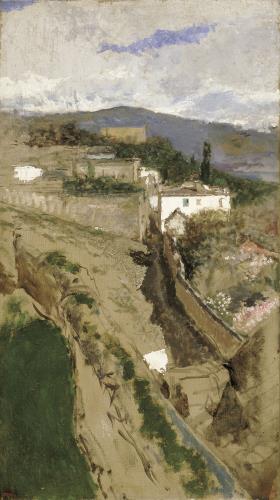
In our opinion, it is necessary to make some reflections on one of the core ideas of his artistic system, one of the most intellectually attractive and one that most marked his future as a painter,given that it called into question his reputation as an effective and decisive author. However, this paradox has gone very much unnoticed, despite the evident depth that was accompanied by the willingness to give up finishing the compositions he had begun. In the case of an author accustomed to not throwing in the towel, with a reputation for being a person who was used to persevering, not giving up something he had begun would mean recognising a disability and leaving the creative process incomplete and mutilated.
Although they turn out to be difficult practices to interpret and we may run the risk of delving into the field of gratuitous speculation, barely founded, the truth is that the typology of unfinished creations, or, to paraphrase it euphemistically, incomplete, transcend the episodic or occasional character, to become a fairly repetitive characteristic that emerges during different stages of his artistic activity.
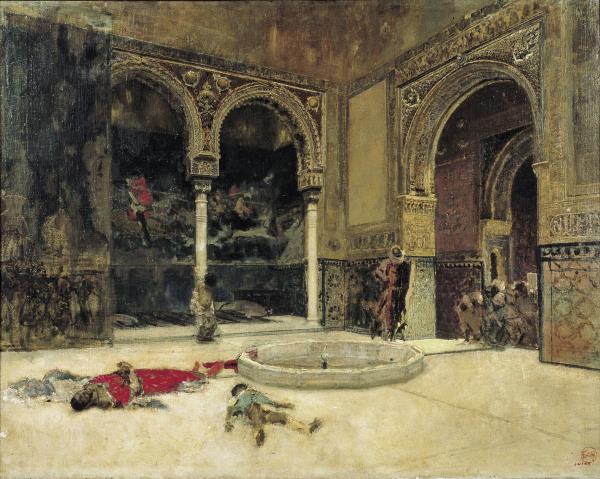
Incomplete works, a constant in the career of Fortuny
In short, it is therefore a dynamic that, due to its repetition, far from appearing intermittently or occasionally, would become a constant that ended up being part of his professional career. As we have already had occasion to point out in some of our published works, this supposed weakness reached its zenith during the period in which the painter established his residence in the city of Granada. From that time we can list, to mention just some of the best known, the following creations in which we find the characteristics mentioned: Granada Landscape (Museu Nacional d’Art de Catalunya), The slaughter of the Abencerrajes (Museu Nacional d’Art de Catalunya);+, Arab musicians (Fortuny Museum of Venice) or Carmen Bastián (Museu Nacional d’Art de Catalunya).
However, beyond mere speculation, we don’t know anything about the causes that could have led to this phenomenon, and even less so could we imagine that, in the work of an artist, recognised for his high degree of perfection and virtuosity, a type of composition far from this perfectionist horizon could coexist at the same time with others in which the impression caused is quite the opposite. In the last case, we are faced with an attitude that, apparently, we could qualify, if we made a very severe, critical judgment based on canonical reasons, as carelessness, idleness or negligence.
Anyway, the truth is that it would be a question of making too hasty a judgment and neither would it be fair, on our part, to consider these incomplete compositions as if they were the result of a sort of professional neglect, of personal abandonment. Perhaps it would be necessary to reverse perceptual prejudices and rather than make a negative reading, it would be convenient to see them as very stimulating exercises, as unconventional types of works, because they force us to reflect and consider, among other aspects, why an artist, gifted of incomparable faculties, and characterised for pursuing a high level of excellence, would decide, at certain moments of his professional life, to leave some of his works unfinished and to move away from those aesthetic references that best reflected an aesthetic ideology with perfectionist characteristics.
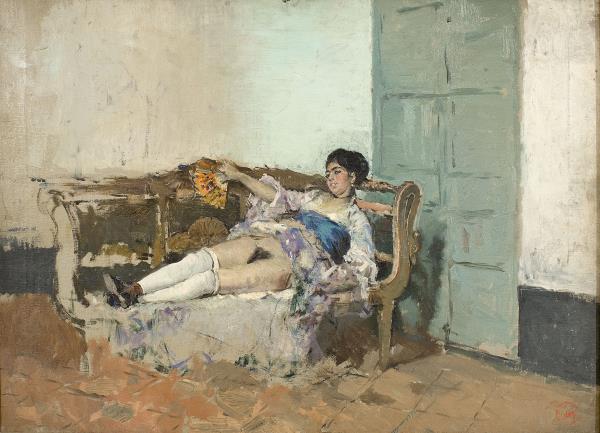
Regarding the previous aspect, one could add a second, more controversial and indirectly related to the canonisation of the painter’s work and the contradictory thing that, apparently, turns out to recognise the authorship of the painter in works that were not finished.
The fact of the matter is that museums, in our opinion, with good criteria, have decided to ignore this precept, and have decided to present his works, despite their appearance, and without intending to, have resulted in ignoring a fundamental issue, given that have ended up contravening the selection criteria that are part of the major heritage institutions and that would respond to the application of immutable archetypes.
Therefore, with their decision, these centres, in a totally accidental way, they have come to recognise that imperfection is also beautiful, it is worthy of the award of the iconic credential, and it is worthy of being contemplated on the walls of a museum. In short, it is a gesture of great importance since it leads to questioning the weight of tradition, removing the conventions and inertias that tend to preside over the management of heritage institutions, accustomed to reluctantly accepting everything that may disturb the fetishist orthodoxy of the canonical object.
Other examples of non finito in the history of painting
Although it may be a controversial statement, we can consider this phenomenon, differences aside, as a happy coincidence with the famous non finito identified with the figure of the versatile Leonardo da Vinci, an aesthetic that was also practised by Michelangelo Buonarroti. With their attitude, both authors foreshadowed a new sensibility, very close to the modern paradigm, which years later would be shared by Fortuny. Broadly speaking, this poetics was characterised by the will to eradicate dogmatic principles and configured a different way of understanding both the creative act and the process of receiving it.
It is also true that in the history of painting there exist a large number of examples that document a highly generalised type of practice among painters and, although it may be paradoxical, if we place ourselves in the context of academic aesthetic ideals and the irradiation of pompier taste, the 19th century was one of the historical periods in which this type of behaviour, so unorthodox, was quite common, since artists never stopped carrying out tests and experimenting.
Without going any further, in the collection of the Museu Nacional d’Art de Catalunya we can find some examples that confirm this trend. Not intending to be exhaustive, we can mention some works by Antoni Fabrés in which we discover this same aesthetic horizon. Specifically, both the Sketch of a Portrait of the painter Francesc Casanovas Gorchs, as well as The Warrior’s Rest, given that they are two unfinished paintings, perfectly illustrate the fortune of a type of very generalised practice among artists of the time.
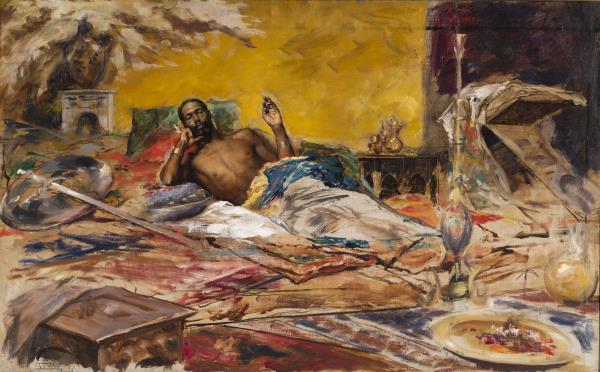
After all, the most interesting thing is that this fact, extended in its use, underlines the existence of a process of breaking up of the canonical model, based on a rigid conception of the artistic phenomenon and, above all, on the existence of a certain type of works that aspire to reproducing an archetype, an idealised image, not even being able to contemplate the possibility that imperfection could also form part of the artistic phenomenon and having the right to enjoy visibility.
In the same way, it is worth highlighting the implications of a model that also contributes to altering the traditional norms of artistic reception. With good reason, an incomplete work forces the spectators to make an additional effort that leads them, before an open work that is revealed before their eyes, to imagine, among a range of infinite possibilities, a possible ending.
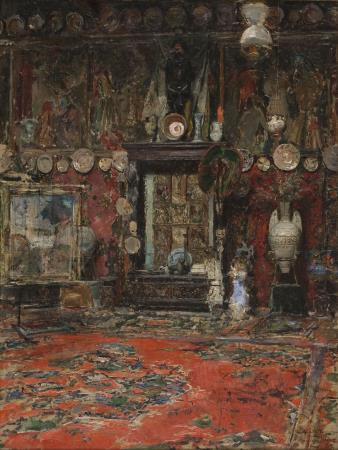
In the absence of an expected and predictable outcome, which used to be crystallised in a finished form, the spectator is subjected to an emotional shock that can range from an initial response of bewilderment to a positive predisposition to understand that the artist, to complete the productive cycle, may be requiring the participation of the spectators, forcing them to collaborate and end a process that had been interrupted. Therefore, it may be the case that, when posed as an open scenario, there exist as many endings, as many possibilities, as spectators that will participate in this process.
Fortuny, demanding and perfectionist
If we take another look at Fortuny’s work, we cannot ignore the fact that we are dealing with an artistic personality who is very demanding of himself. This ambitious horizon of expectations could explain the appearance of these sporadic episodes in which the formal distance that separated the desire from reality can be observed.
We would therefore be in front of the recognisable expression, even if it was perceived in an unconscious way, of dissatisfaction or discomfort caused by the inability to materialise the artistic idea, to give it a full form, generating a feeling of frustration that, in the case of some of the most compromising commissions, would also help to understand a process of drawing out time. The same can be said of all those who raised doubts about the most convincing way to solve compositional problems, or the most effective, most decisive way of approaching the subject.
In any case, we cannot ignore what the artist’s own attitude was. On many occasions, he positioned himself, without any ambiguity, and did not hesitate to put to one side, in a conscious and voluntary way, and if needs be, he considered the work to be necessary because he was not capable of meeting the expectations created.

In this sense, it is worth remembering the long process of creation, the stretching out of time, which some of his most canonical productions suffered from, those that, paradoxically, have contributed the most to increasing the legend of the painter. Without going any further, we can mention endless examples ranging from the unfinished The Battle of Tetouan (Museu Nacional d’Art de Catalunya), as a model of an early work, until his posthumous work, Beach at Portici (Meadows Museum), as an example of a work that he began a few months before his death.

Related links
Fortuny’s Carmen Bastián: problems with its reception and interpretation
Marià Fortuny: painting as the representation of a worldview
Scenes of creation: artists’ workshops / 1
Scenes of creation: artists’ workshops /2
Antoni Fabrés. De la gloria al olvido. Exhibition catalogue
Fortuny 1838-1874. Exhibition catalogue
Francesc Quílez, Balance de un tiempo feliz
Gabinet de Dibuixos i Gravats







